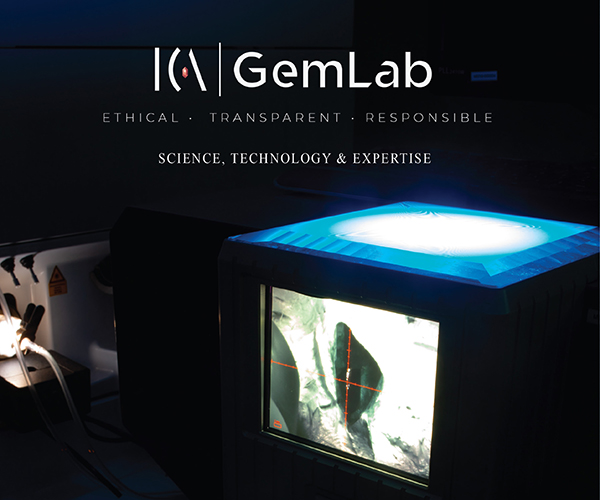You can never change things by fighting the existing reality. To change something, build a new model that makes the existing model obsolete.
Buckminster Fuller
We tend to think of gemstones as innate objects of beauty, but in fact they are the very archetype of the universe that conveys and communicates the deeper realities of our universe.
Glenn Lehrer, from his book In Quest of the Indescribable.
With the explosion of new cutting styles in the gemstone industry worldwide, along with a growing movement for ethically sourced and produced gems, the colored stone industry is racially changing. With its roots going back to the 1950s, this quiet revolution is distinctive and innovative, unlike anything the industry has seen before.
There are several factors that have been building and maturing for the last seven decades that are synergistically creating a whole new level in the way the industry produces cut stones and how it conducts business from mine to market.
In the 1980s, an eruption of new cutting styles dramatically changed the way gems were cut from the previous 500 years. A few key factors have contributed to this notable change:
♦ The establishment of groups of individual pioneering lapidary artists both in Germany and America;
♦ Radical new machines, concepts and techniques in the science of optics for cutting transparent gem material;
♦ Access to rough via social media versus traveling to producer countries;
♦ An explosion of new cutting styles and methods;
♦ Ever-growing customer demand for socially responsible and ethically sourced and manufactured goods, transforming how gems go from mine to market;
Jewelry historians may very well look back upon this time, marking this historical period as a renaissance within the gemstone industry. A genius moment occurred in the 1980s when lapidarists went beyond just flat faceting and started carving reflective negative cuts into transparent gem material. This gave birth to a whole new way of seeing how reflected light dances in a gemstone—to the Fantasy Cut.
Bernd Munsteiner from Idar-Oberstein, Germany is credited for having started this new cutting style of combining flat faceting and carved negative cutting processes during the 1970s and 1980s. His trailblazing path has inspired countless future aspiring lapidarists. His brilliant combination of strategically placed reflective flat facets and surgically carved negative grooves was truly revolutionary.
Looking Back
The lapidary movement can be traced back to the 1950s and 1960s in the United States, where no real lapidary tradition or Guild system existed like there was in Idar-Oberstein, with its 500-year heritage and master and apprenticeship programs. In San Francisco, California, lapidarist Francis J. Sperisen was the first professional pioneer in creative gem art. He was the go-to gem cutter, carver and inventor for many beat-generation jewelers.
His book The Art of the Lapidary published in 1950 and 1961 was one of the most influential books in gem cutting for future American gem artists. Written originally for the growing American amateur lapidarist in association with gem and mineral societies, clubs, and faceter guilds throughout the country, Sperisen’s book became an inspirational light for future American professional lapidarists like myself.
On the heels of Francis Sperisen was Henry Hunt, who acknowledged Sperisen for inspiring his own creative and unorthodox gem carving. Hunt’s work enlightened and inspired many future professionals and hobbyists in America. In the 1970s, he created a completely novel and unique form of gemstone carving. His self-published book, Lapidary Carving for Creative Jewelry (1980) describes techniques in carving transparent colored stones. Many young lapidary artists in the United States give Hunt credit for spreading knowledge about his many techniques and tooling.
My own career began in 1976 when I began teaching myself various techniques in the art of carving. Not long after, I met Henry Hunt in a San Francisco jewelry store where we both sold our work. Both of us were pleasantly surprised that there was another individual doing non-transitional lapidary designs in transparent gem material.
By the late 1970s and 1980s, a small and committed core of gem artists was active in the USA. Yet, they were geographically isolated, each developing his or her own innovative style of cutting and carving. This small handful of enthusiasts explored new approaches to cutting and carving, without any formal training or access to resources or information. Most of us from this First Wave were unaware of one another and were self-taught. We learned the craft by shear gumption and inventiveness.
Ten years into my carving and cutting career, with a Graduate Gemology degree under my belt, I ventured to Idar-Oberstein (circa 1986). I was lucky enough to gain access and training with some of the masters in the valley, learning age-old techniques while demonstrating my own innovative approaches to cutting and polishing gems. This wonderful cross-fertilization of ideas between American and German gem artists continues to this day.
The small cadre of First Wave American carvers—although largely self-taught innovative cuts and techniques—produced some amazing results. During this period, among the most well-known lapidarists were the late Arthur Anderson, Sherris Cottier-Shank, Bart Curren, Michael Dyber, Mark Gronlund, Richard Homer, Thomas McPhee, Lew Wackler, Steve Walters, Larry Winn, Larry Wood, and myself.
We created and sold work to modern jewelry and goldsmith designers in the USA and Europe. We each had our own style and techniques and eventually laid the foundation for future generations of gem carvers in the United States and around the world.
After the First Wave came the Second Wave, starting in the 1990s with a new generation of cutters drawn into the exciting and emerging profession of Lapidary Art. Many have reached worldwide acclaim, such as Dalan Hargrave, John Dyer, and Daryl Alexander to name just a few. In the Third Wave, happening now, individuals and companies worldwide are engaged in fantasy gem cutting, taking these styles to remarkable new levels.
Tools and Techniques
In the 1930s, the fixed-mast faceting machine was invented, leading amateur gem cutters and mineral societies to make this form of faceting popular in the United States. These machines have a fixed mast and quill versus the gem-peg style machine. It helped raise the bar in faceting by allowing the creation of complex and brilliant facet patterns. Since the users were not professionals, they openly shared their facet patterns and techniques. Over the years, a series of books were published on gem cutting. Among them were Faceting for Amateurs by Glenn and Martha Vargas (circa 1977) and the Long and Steele binder series of meet-point faceting.
In Idar-Oberstein, however, the refinement and advancement of the gem-peg faceting machine (used for accuracy and speed) was exported worldwide and is the standard for larger production factories doing calibrated cutting.
Along the innovative path in lapidary, there have been technological leaps forward in the types of tools and machines used to create this art form. With the evolution of ideas and styles, the tools and equipment have also undergone a technical shift. One such machine is the OEM concave faceting machine, pioneered by Richard Homer.
It is a clear example of a new invention and influencer in the trade. This machine uses various size cutting and polishing cylinders to create concave curved facets versus the traditional flat facet. The concave facet style is now well integrated as a distinctive style throughout the gem industry.
Milling style machines that engrave complex patterns in gemstones are also being used. Developments in automated faceting and CNC machines allow the cutting and carving of gems at production levels. Today, the major factories in India and China (and elsewhere) that produce quantity calibrated goods use this type of equipment. While 30 years ago, one-off original cuts by a gem artist received recognition for their individuality, today, these same styles can be manufactured in quantity by factories around the world.
In 1998, a United States Utility Patent was awarded to me for inventing a unique and novel gemstone branded cut that we called the TorusRing™ Cut (U.S. Patent #5,722,261). I intended for this cut to be calibrated.
In 2008, I took my TorusRing™ Cut and other fancy branded styles to a factory in Jaipur, where I trained cutters to take my one-of-a-kind cuts and reverse engineer them to produce large calibrated quantities for wholesale jewelry manufacturers, trade catalog sales, and finished jewelry products for television volume sales.
Taking Credit/Branding
For the first time in gemstone history, lapidary artists are signing their work. This is a radical shift from centuries of tradition. Dating back to Roman times, lapidarists were never given direct credit nor allowed to sign their pieces unlike artists in other media, who were commissioned by the church or royal court houses in Europe and Asia. In the 1970s, renowned master cameo carver Erwin Pauly started the practice of signing his work. He stated that, in those days, he was criticized in the Idar valley for being bold enough to sign and brand his style of cameo carving. Pauly also broke the mold of cameo carving by branching out from carving the classics of Roman, Greek, and Christian iconology; he created Art Deco motifs and modern cityscapes in layered agate cameos, which opened up new avenues in this art.
Munsteiner branded all of his work by adding his signature. Today, it is accepted and often requested by the consumer that the gem artist sign his or her pieces.
In the 1980-90s, branded cuts were also created by American master professional faceters such as Philip Youngman and Steve Avery. Completely brilliant from girdle to Round 38.28-ct ametrine TorusRing™cut, by Glenn Lehrer. (Photo: Glenn Lehrer) culet, these complex patterns and higher crowns are growing in popularity with many fine jewelry designers around the globe.
It is no longer just about weight retention, but about light performance. Windowed gemstones with greater weights have given way to finer more intricately faceted, fully brilliant gemstones. Buyers are willing to pay more for a lower carat weight if the stone is fully brilliant. We’ve reached a pinnacle where absolute reflection of light from culet to girdle has become the standard. Some of the most valuable gemstones— such as ruby, sapphire and emerald—are now cut to this standard. Beauty is what sells, and a really well-cut stone is what the industry is demanding.
In 2020, it is clear that faceting, carving, and concave-cutting of colored stones have reached a significant milestone around the world. Gemstones are not just desired for their intrinsic value, but for their original cutting and branding that have become the new industry standard.
Ethics and More
A significant current change in the gem industry is the emerging global awareness of ethics and socially responsibility in the supply chain. Consumers are demanding that gemstones be ethically mined and handled in a socially acceptable manner. Important issues are human dignity and rights, no child labor, gems that are free from corruption and links to terrorism, verifiable blockchain paths from mine to market, and environmental protection. These concerns are taken seriously today by increasing numbers of industry trade associations, catalog companies, and design houses, both large and small.
In many emerging economies where colored stones are found, such as in areas of Africa and Asia, gemstone mining is the easiest and quickest way to start a supply chain that results in a revenue stream for even the remotest of villages. Most colored gemstones are mined in a small-scale, individual, or artisanal manner. People in developing countries are aware that gemstones offer a path to economic development.
Many of us in the colored stone industry are acutely aware of the changes happening in remote areas of the world and have taken on the responsibility of finding ethical sourcing and production of gems.
One of the pioneers in this effort is Eric Braunwart from Columbia Gem House. For the past 20 years, he has been a leader and outspoken proponent for ethically sourced and cut gemstones. Today, it is clear that the industry is concerned about the many steps that a gemstone travels on its journey from the Earth and wants to ensure that it comes to market in a socially responsible manner.
In conclusion, the industry has changed forever. It has made significant innovations in the quality of cutting, design style, brilliance, branding, mining, manufacturing, and social responsibility. This lapidary revolution has brought beauty, color, and light to humanity.
References
- Hunt, Henry (1980) Lapidary Carving for Creative Jewelry. The Desert Press.
- Lehrer, Glenn W. (2016) In Quest of the Indescribable, The Artistry and Life of a Gem Carver. Gemporia Ltd.
- Sperisen, Francis J. (1950, 1961) The Art of Lapidary. The Bruce Publishing Company.
- Vargas, Glenn and Martha (1977, 1978, 1980, 1983) Faceting for Amateurs, Published by authors at Desert Printing Co., Indio California. There is also follow-ups series Volume 1, II and III published with a large list of diagramed facet patterns.
- Wise, Richard W. (2003) Secrets of the Gem Trade, The Connoisseur’s Guide to Precious Gemstones. Brunswick House Press.














